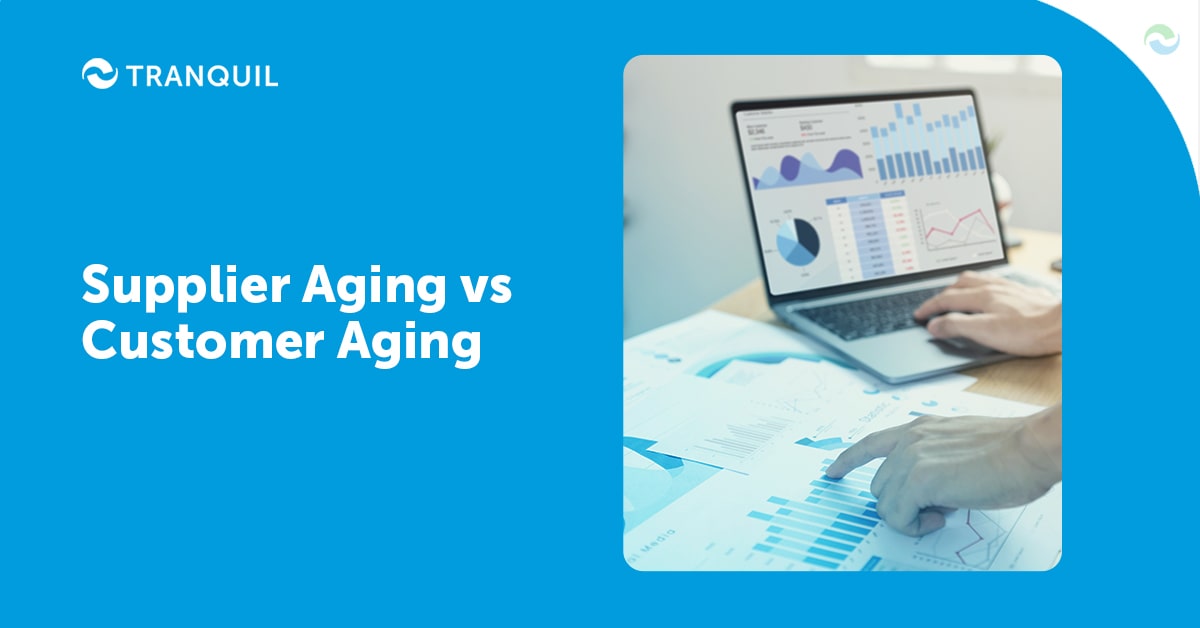
No, we’re not talking about the age of your customers and suppliers in years.
Supplier aging is also known as accounts payable aging, and customer aging is also called accounts receivable aging.
Let’s clear the air and understand what both these terms mean and what their importance is in accounting.
ALSO READ: Tips to Improve Inventory Turnover
Accounts receivable or customer aging refers to the period of time an invoice hasn’t been paid by a customer.
This often reflects the state of the company’s finances and dependability of their customers.
The customer aging report is prepared periodically to assess how much money the business is owed by its customers.
You can see how quickly or slowly you are able to collect money from your customers.
If it is too slow, it could signal a higher credit risk in sales, or that the business itself is slumping.
ALSO READ: Importance of Cash Book in Accounting
Customer aging is a management technique that identifies high-risk customers, enabling management to take a call about continuing to sell to those customers who are perpetually late with payments.
The customer aging report contains columns, normally broken into month-long date ranges, showing the total amount due at present, and the dues for every month.
Some businesses may follow a strict 30-day period as well.
Whenever a customer makes a payment against an outstanding invoice, whether current or past due, you must reduce the accounts receivable against that customer by that much amount.
So, if a customer owes you SAR 2500 and it is past due for about 40 days, and he pays you the full amount, you must ensure that that column is now brought to 0.
ALSO READ: What is a Ledger in Accounting?
Customer aging reports are valuable in deciding what to do about doubtful accounts.
When you are preparing the financial statements, you need to estimate how much bad debt should be mentioned.
The customer aging report helps in determining the write-off amount.
The most valuable aspect is getting the aggregate of accounts receivables, depending on how long the invoice has been unpaid in days or months.
If invoices remain unpaid for over six months, the possibility of collecting on them become very slim – unless you take legal recourse.
Each date range is assigned fixed default percentage, with invoice unpaid for long time periods being assigned higher percentage due to the higher risk of default, and reduced chances of collection.
The total of products from every data range offers an idea of how much uncollectible receivables is there in total.
ALSO READ: How to Understand and Manage VAT for Your Business?

The customer aging report helps a business in numerous ways.
Accounts receivables is basically credit that is extended to customers.
The aging report shows the customers who are consistently paying late, and this can help management take a decision whether to extend further credit or do business only on a cash basis with these customers.
They are helpful in writing off bad debts; we saw earlier how the total amount of accounts receivables helps accountants determine who much bad debt is to be shown in the company’s book of accounts and on the financial statements.
By tracking unpaid invoices, the business can identify the number of accounts they will be unable to collect from, and also evaluate cash flow problems and potential credit risks.
ALSO READ: Debit Note vs Credit Note
The customer aging report also forms the base for generating letters for collection to customers with long outstanding balances.
Businesses usually send copies of the report to customers together with a collection letter or month-end statement that mentions details of outstanding invoices.
This means that accounts receivables aging report is used both internally and externally.
The unpaid accounts are listed in chronological order of their payment status.
There are different slots like current, less than 30 days, 60 days, etc.
Depending on how many accounts are aged over 180 days, a business can get an approximate figure of outstanding accounts receivables to be written off in the future.
ALSO READ: Ways To Do Budget Variance Analysis
While customer aging reports offer several benefits, there are two main reasons why a business keeps track of them:
ALSO READ: What is Asset Depreciation?
Businesses almost always purchase goods for sale or raw materials for production on credit.
Companies that deal in a large number of products may find it overwhelming to keep track of how much they owe to different suppliers.
A supplier aging or accounts payable aging report can be of great help in such cases.

To understand this, it is essential to first get a clear and complete understanding on what accounts payable is.
To put it simply, accounts payable is the money you owe to your suppliers; the debts you owe them for the purchase of services, inventory, raw materials, and anything else, for operating your business.
Your accounts payable increases every time you make a credit purchase.
The seller or supplier generates an invoice in your name and you pay them at a later date.
Ergo, a supplier aging report lists the amounts you owe to other providers and have not paid.
It helps you see at a glance how much you have to pay, and to organize these amounts.
ALSO READ: Guide on Inventory Demand Forecasting
Supplier aging reports include the following:
A detailed supplier aging report offers an uncomplicated method of tracking and managing your accounts payable, allowing you to make timely payments, and eliminating late fees of other penalties, legal actions by your vendors, and the loss of reputation in the market.
The accounts payable report helps you in:
ALSO READ: Tips to Increase Gross Margin Return on Investment (GMROI)

The supplier aging report contains columns that help in categorizing your suppliers, the invoice age, names of you suppliers, the amounts you owe them, and so on.
There is a separate row for each vendor which mentions the total amount you owe them, and, if applicable, the amount that is past due.
The supplier aging schedule contains columns that classify your debt depending on the invoice age.
Every column refers to a specific period of time after receipt of the invoice – usually that time period is 30 days.
ALSO READ: What is Job Costing?
So you may have columns like:
So as long as you pay within the first 30 days of the issue of the invoice, it is not past due; it is from the 31st day after the invoice date that your past due days are counted.
If the invoice is not paid within the first 30 days, it becomes past due. And depending on how long you have not paid the invoice, it is put into one of the columns.
For example, if you have received an invoice on March 1st, then you have 30 days to pay, so you must pay on 31st. On the 1st of April, it becomes one day past due.
The supplier aging report maintains a running balance on the amount owed to various suppliers.
ALSO READ: Ways to Improve the Procurement Process
Every time you purchase goods and services on credit, your accounts payables increase; when you continue to buy from the same vendor on credit, you could end up owing one supplier for numerous transactions.
The report helps you see which payments are already past due, and you can make a decision regarding which debts to pay off first.
Every time you pay off an invoice, either current or past due, that amount is to be deducted from the respective column in your supplier aging report.
Suppose you pay SAR 5000 to a vendor to whom you owe SAR 7000, and the invoice amount was in the ‘more than 31 and less than 60 days’ past due column, you should delete that amount and ensure that the column against that vendor’s name reflects the new balance of SAR 2000.
When you use the accounting software from Tranquil, it will automatically update the balance in the accounts payable aging report by deducting the amounts paid.
ALSO READ: Challenges in Procurement and Supply Chain
You can ensure that your report is accurate and valuable by considering these:

We have seen what customer aging is and how it impacts the business, and what supplier aging is, and the effect it can have as well.
Both reports help businesses to handle their cash flow better and plan for future expenses and budgets more effectively.
Let us now take an in-depth look at the difference between an accounts payable aging report and an accounts receivable aging report.
We will refer to customer aging as AR and supplier aging as AP, for short.
One thing is very clear. They are both the opposites of each other.
ALSO READ: Vital Procurement KPIs You Cannot Ignore
You can create supplier and customer aging reports manually or be smart and leverage automation. Tranquil ERP is an efficient solution with a robust finance and accounting module that helps you keep track of your accounts payables and receivables, and eventually, save money and time.
For more details of how it can benefit your business, schedule a free demo now!